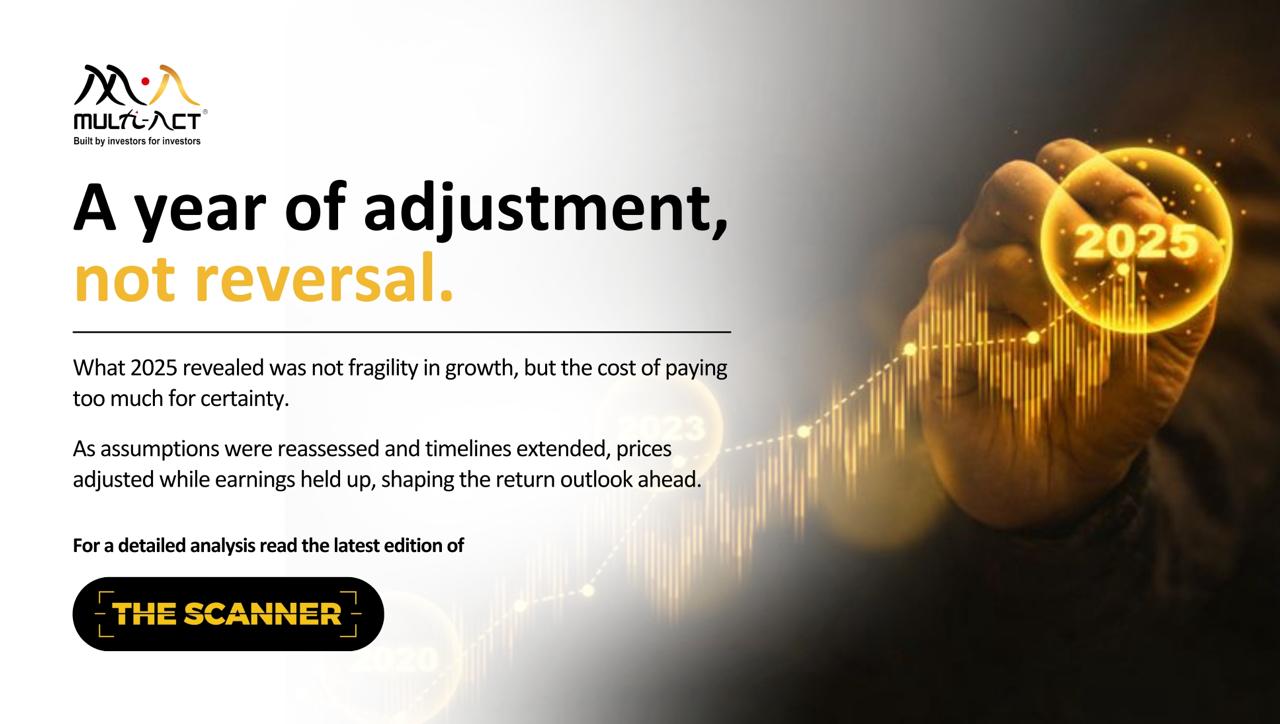
What Happened and What’s in Store for 2026
2025 did not challenge growth. It challenged assumptions. As expectations moved ahead of actual delivery, prices adjusted … Continued
Read more19 March 2021

What do the following examples of 3-year and 5-year returns tell you about the stock market?
i. If you had invested in Jan 2008 (when the market valuations were at a historical peak), your 3-year prospective returns (CAGR) would have been negative 2.1% and 5-year prospective returns (CAGR) would have been a negative 0.9%.

ii. If you had invested in Oct 2008 (when the market valuations were at a historical low), your 3-year prospective returns (CAGR) would have been 27.3% and 5-year prospective returns (CAGR) would have been 19.3%.

We have been very selective in quoting the above examples. In fact, in example # 1, we have calculated prospective returns when the valuations were above +2 SD (based on normalised valuations).
But you get the point, right?
These examples show the importance of entry points in the market. Valuations matter in determining medium to long term returns. Higher starting values mean future expected returns are lower, and vice versa.
Let’s us understand this with the example of Nifty’s valuations and prospective returns of 3 years and 5 years when the normalised valuations reach + 1 SD.

From the above chart,
Whenever the normalised PE of Nifty goes above +1 SD, prospective return for 3 year and 5-year period shows a low single-digit return (even negative returns).
In the extreme case (Jan 2008 market peak), when the normalised PE went above + 2 SD, the prospective returns for the next 3-year and 5-year were negative.
Now let’s look at the table on the right of the chart.
The table shows the average 3 year and 5-year CAGR from any given point within each standard deviation band.
If you would have invested at any point above +1 SD, the average return would have been around 3.5%. Conversely, if you would have invested at a point when the Nifty valuation was below -1SD, the average return would have been more than 20% from a 3 and 5-years perspective.
Thus, if we look at it from a perspective of probability, the probability of making high returns diminish as valuations become expensive.
Clearly, the more you pay for an asset relative to its underlying fundamental returns as a business, the less return you should expect to receive going forward as a shareholder.
Apart from poor returns, an investor suffers from the drawdown risk. The below table shows the worst loss that the investor had to face over the next 3-5 year holding period during those 4 historical points shown on the chart.

Thus, not only did the investor end up with poor returns, but he had to go through gut-wrenching mark-to-market loss in the interim.
As we know, when one experiences a 20% drawdown, to get back to the original level, one needs a 25% gain. Or take a 50% loss. Now, to come back to the original level, one needs a 100% gain.
The steeper the drawdown, the more daunting it is to get back to the starting point.
Not all investors have the ability to withstand such losses. More importantly, few have the discipline to hold on through the pain and may sell at the wrong time to minimise losses just as the odds in favour of the investor are improving.
The disciplined few, who may hold on, would be rewarded with only a low single-digit return at the end of 3-5 years.
Thus, at the end of 3-5 years, the investor would wonder if it was really worth it.
Through this analysis, we are not suggesting a market crash is imminent. For someone who decides to invest today, might still end up making decent returns after 3-5 years if current high valuations go higher or remain the same.
However, one needs to consider the base rate. The base rate is a technical term for describing odds in terms of prior probabilities. For example, the base rate of having a drunken-driving accident is higher than those of having accidents in a sober state.
Similarly, investing when the valuations above +1 SD suggest a higher probability of mediocre returns in the coming 3- and 5-year period. Clearly, the odds are stacked against an investor today.

2025 did not challenge growth. It challenged assumptions. As expectations moved ahead of actual delivery, prices adjusted … Continued
Read more
Macro numbers alone rarely tell the full story. When jobs, consumption, credit, and inflation are considered together, … Continued
Read more
The AI story everyone sees is technological. The story that a few notice is financial. Revolving expenditures, … Continued
Read moreReceive monthly updates by signing up to our newsletter.
| Sr. No. | Received from | Pending at the end of last month | Received | Resolved* | Total Pending # | Pending complaints > 3 months | Average Resolution time^ (in days) |
|---|---|---|---|---|---|---|---|
| 1 | Directly from Investors | 0 | 0 | 0 | 0 | 0 | 0 |
| 2 | SEBI (SCORES) | 0 | 0 | 0 | 0 | 0 | 0 |
| 3 | Other Sources (if any) | 0 | 0 | 0 | 0 | 0 | 0 |
| Grand Total | 0 | 0 | 0 | 0 | 0 | 0 | |
Number of complaints received during month against the IA due to impersonation by some other entity: Nil
Note: In case of any complaints received against the IA due to impersonation of the IA by some other entity, the IA may adjust the number of such complaints from total number of received/resolved complaints while preparing the above table. Further, IA must close such impersonation related complaints after following the due process as specified by SEBI/ IAASB.
* Inclusive of complaints of previous months resolved in the current month.
# Inclusive of complaints pending as on the last day of the month.
^ Average Resolution time is the sum total of time taken to resolve each complaint in days, in the current month divided by total number of complaints resolved in the current month.
| Sr. No. | Month | Carried forward from previous month | Received | Resolved* | Pending# |
|---|---|---|---|---|---|
| 1 | April, 2025 | 0 | 0 | 0 | 0 |
| 2 | May, 2025 | 0 | 0 | 0 | 0 |
| 3 | June, 2025 | 0 | 0 | 0 | 0 |
| 4 | July, 2025 | 0 | 0 | 0 | 0 |
| 5 | August, 2025 | 0 | 0 | 0 | 0 |
| 6 | September, 2025 | 0 | 0 | 0 | 0 |
| 7 | October, 2025 | 0 | 0 | 0 | 0 |
| 8 | November, 2025 | 0 | 0 | 0 | 0 |
| 9 | December, 2025 | 0 | 0 | 0 | 0 |
| Grand Total | 0 | 0 | 0 | 0 | |
* Inclusive of complaints of previous months resolved in the current month.
# Inclusive of complaints pending as on the last day of the month.
| SN | Year | Carried forward from previous year | Received | Resolved* | Pending# |
|---|---|---|---|---|---|
| 1 | 2021-22 | 0 | 0 | 0 | 0 |
| 2 | 2022-23 | 0 | 0 | 0 | 0 |
| 3 | 2023-24 | 0 | 0 | 0 | 0 |
| 4 | 2024-25 | 0 | 0 | 0 | 0 |
| Grand Total | 0 | 0 | 0 | 0 | |
* Inclusive of complaints of previous years resolved in the current year.
# Inclusive of complaints pending as on the last day of the year.